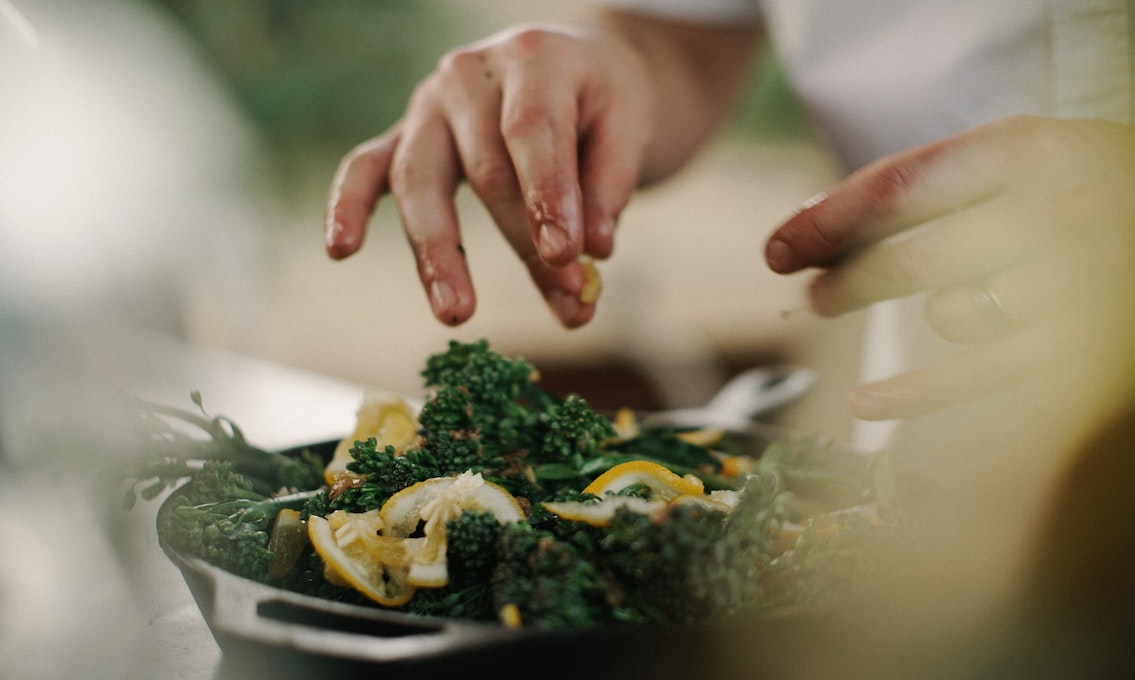It’s often said that a healthy lifestyle starts in the kitchen, but while cooking fresh foods from scratch can make it much easier to achieve a healthy diet, you could also be jeopardising your gut health if you aren't storing, prepping and cooking food in the right way.
Rates of foodborne illnesses have risen over the last few years, with cases hitting 2.4 million last year according to the Food Standards Agency, so it's important not to get complacent.
Here, we’ve shared ten common mistakes that could be putting you at risk of getting a foodborne illness or digestive trouble.
1. Eating raw ingredients
When baking, it’s often tempting to steal a bite of uncooked cookie dough or brownie batter, or to lick the spoon before doing the washing up.
But as tasty as this might be, it can also be quite risky, because uncooked dough and batter contains raw eggs and flour that may carry harmful bacteria, like salmonella or E. coli.
So, to keep your gut healthy, wait until those baked treats have been cooked before tucking in.
2. Using metal utensils on non-stick cookware
Non-stick cookware can be a fantastic addition to your kitchen equipment collection — they stop food from getting burnt onto pots and pans, and are easy to clean.
However, it’s important to make sure that you’re using them correctly: if you don’t, the surface can become scratched during cooking, and the non-stick coating may flake off and get into your food.
The coating that gives these pans their non-stick properties is perfectly safe to cook with, but it can be harmful if accidentally ingested, and may lead to gut health issues.
To prevent this from happening, you should avoid using metal utensils on your non-stick pots and pans, and instead use silicone tools or wooden spoons.
You should also avoid using scourers or other abrasive cleaning equipment too. If you notice that the surface of the pan is starting to get scratched or flaky, replace it as soon as possible.
3. Using the same chopping board for all foods
While it might be convenient to chop all your ingredients on one chopping board, doing so can be incredibly dangerous for your gut health.
This is because raw ingredients like meat and seafood — while high in protein and full of nutrition — can carry food-borne diseases and harmful bacteria until they have been thoroughly cooked.
As such, they should never come into contact with other raw ingredients, like vegetables and dairy, when you are prepping your meals.
In professional kitchens, chefs use colour-coded chopping boards for meat, vegetables, fish, and dairy, and take care to clean and store them all separately to avoid any risk of cross contamination. So, it may help to invest in a set of coloured boards that you can use for different cutting tasks.
You should also be careful to wash your chopping boards between each use: using hot, soapy water and an antibacterial cleaner, or putting them in the dishwasher, should get rid of any harmful bacteria.
4. Using old, scratched chopping boards
While we’re on the subject of chopping boards, it’s also important to note that you should avoid using very scratched or damaged boards.
This is because particles of food can easily get stuck in the tiny gaps on the surface of the board, and it can be very difficult to remove them, even with thorough cleaning, which in turn increases the risk of your foods becoming contaminated by bad bacteria.
So, if your plastic chopping boards have lots of nicks or scratches in them, it’s time for a replacement.
For wooden chopping boards, you can also try sanding the surface down to remove any light scratches.
5. Defrosting food at room temperature
Defrosting foods in the fridge can take hours or even days, and as a result, it’s often tempting to just leave it out on the countertop for a few hours to help speed things up. However convenient this might be, it’s also very hazardous, as harmful bacteria can multiply rapidly in warmer temperatures.
To be on the safe side, you should always take the safest option and defrost food in the fridge. Once it’s fully thawed, the Food Standards Agency recommends eating defrosted food within 24 hours.
If you forget to take something out of the freezer ahead of time, you can also use the defrost function on your microwave to quickly and safely thaw it out before cooking.
6. Eating too many high FODMAP foods
Certain foods can be very high in FODMAPs — or fermentable oligosaccharides, disaccharides, monosaccharides, and polyols, to give them their full names.
These are short-chain carbohydrates that our bodies can struggle to digest, and it’s thought that they may interfere with gut health and worsen conditions such as irritable bowel syndrome.
If you often struggle with digestive problems, it may help to cut down the amount of FODMAP-high foods in your diet.
Meat, poultry, and fish are all naturally FODMAP free, and so are perfect for those who are sensitive to FODMAPs. However, certain processed meats — like deli meat, or ready meals — may contain added ingredients that are high in FODMAPs, such as garlic or onion. Instead of these, it’s best to buy raw meat without any marinades or other ingredients and cook them from scratch.
7. Not refrigerating your leftovers
We should all be trying to save and re-use our leftovers wherever we can in order to reduce food waste. But, leaving cooked food out on the counter for too long provides the perfect conditions for bad bacteria to multiply.
Always put leftovers in the fridge as soon as they have cooled down, and throw away any cooked food that has been sitting at room temperature for over two hours.
8. Not following proper fridge hygiene
Stacking your fridge properly is about much more than just staying organised — it’s vital for preventing cross contamination.
Cooked and raw food should always be kept on separate shelves, and it’s best to keep meat and dairy on the bottom shelf, so any leaks can’t drip down onto other foods.
Fruit and veg is best stored in a drawer or crisper, which will protect it from cross contamination and keep it in good condition.
It’s also important that your fridge is chilled properly, because if it isn’t cold enough, harmful bacteria is more likely to grow in your food.
According to the Food Standards Agency, you should aim to keep your fridge chilled to 5°C or below. Using a fridge thermometer is the easiest and most accurate way to check this.
The shelves inside the fridge door are usually the warmest part of the fridge. So, although it might be convenient, you should avoid storing milk and dairy here.
Instead, you can use the door to store jars of sauce or preserves, as these don’t need to be kept as cold as dairy.
9. Not rotating foods
It can be all too easy to forget what food you’ve got at the back of the fridge until it’s gone off. This is why restaurants and caterers use the first in, first out (FIFO) system to help stay on top of fresh produce and raw meats.
This system involves stacking older, less fresh foods towards the front of your fridge, and newer items towards the back.
This way, it’s easier to stay on top of what needs eating and when, and it also helps to stop food from going bad and potentially contaminating other items in the fridge.
10. Overusing cleaning tools
Your kitchen equipment is only as clean as the tools you use to wash it, so if you’re using an old, dirty sponge or dishcloth, you could be putting yourself at risk.
To stop your dish sponges and cloths from becoming breeding grounds for germs, always take care to rinse them with hot water after washing up, and then squeeze out any excess liquid before leaving them to dry on a small dish overnight.
You should also be replacing dish sponges every week or so to keep them fresh and clean.
Cloths and tea towels should be swapped out for clean versions and laundered every two days or so. Washing them on a hot cycle in the washing machine with an antibacterial detergent will help to kill off any lingering harmful bacteria.
The Bottom Line
Healthy habits start in the kitchen, but if you’re not careful, you could accidentally be doing more harm than good.
Watch out for the common mistakes we’ve shared here, and you should be able to reduce the risk of foodborne illness and improve the overall health of your gut.
Guest blog by Mike Hardman, Marketing Manager at catering and hospitality supplier Alliance Online.




























Leave a comment